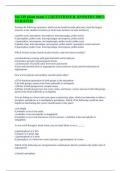bio 240 plant exam 1 || QUESTIONS & ANSWERS 100%
VERIFIED.
Arrange the following structures, which can be found on male pine trees, from the largest
structure to the smallest structure (or from most inclusive to least inclusive).
a.)pollen cone, sporophyte, microspores, microsporangia, pollen nuclei
b.)sporophyte, pollen cone, microsporangia, microspores, pollen nuclei
c.)sporophyte, microspores, microsporangia, pollen nuclei, pollen cone
d.)pollen cone, microsporangia, microspores, pollen nuclei, sporophyte correct answers
b.)sporophyte, pollen cone, microsporangia, microspores, pollen nuclei
Which of these events, based on plant fossils, came last (most recently)?
a.)carboniferous swamps with giant horsetails and lycophytes
b.)extensive growth of gymnosperm forests
c.)colonization of land by early liverworts and mosses
d.)rise and diversification of angiosperms correct answers d.)rise and diversification of
angiosperms
How are bryophytes and seedless vascular plants alike?
a.)The dominant generation in both groups is the sporophyte
b.)In both groups, sperm swim from antheridia to archegonia
c.)Plants in both groups have vascular tissue
d.)Plants in both groups have true roots, stems, and leaves. correct answers b.)In both groups,
sperm swim from antheridia to archegonia
You are hiking in a forest and come upon a mysterious plant, which you determine is either a
lycophyte sporophyte or a monilophyte sporophyte. Which of the following would be most
helpful in determining the correct classification of the plant?
a.)its height
b.)whether or not it has seeds
c.)whether it has microphylls or megaphylls
d.)whether or not it has true leaves correct answers c.)whether it has microphylls or
megaphylls
As you stroll through a moist forest, you are most likely to see a _____.
a.)gametophyte of a fern
b.)zygote of a green alga
c.)gametophyte of a moss
d.)sporophyte of a liverwort correct answers c.)gametophyte of a moss
Which of the following sex and generation combinations directly produces the pollen tube of
angiosperms
a.)female sporophyte
, b.)male sporophyte
c.)male gametophyte
d.)female gametophyte correct answers c.)male gametophyte
Which of the following characteristics is functionally important in cells of the gametophytes
of both angiosperms and gymnosperms?
a.)diploid nuclei
b.)mitochondria
c.)chloroplasts
d.)Endosperm correct answers b.)mitochondria
Compared to nonvascular plants, the ancient relatives of vascular plants ________.
a.)produced sporophyte generations independent of, not dependent on, gametophyte
generations
b.)probably experienced less competition for light
c.)produced sporophyte generations that provided more nutrition to gametophyte generations
d.)produced much smaller sporophyte generations correct answers a.)produced sporophyte
generations independent of, not dependent on, gametophyte generations
Four broad groups of plants correct answers angeosperms,gymnosperm,nonvascular,seedless
vascular plants
Bryophytes correct answers gametophyte dominant no true stems or leaves
Alternation of Generations correct answers the alternation between the haploid gametophyte
and the diploid sporophyte in a plant's life cycle
gametophyte correct answers gamete-producing plant; multicellular haploid phase of a plant
life cycle
Sporophyte correct answers Diploid, or spore-producing, phase of an organism
Nonvascular Plants correct answers First plants to colonize land ~475 million years ago.
Lack,xylem and phloem for transporting water and nutrients,Lack roots for anchoring and
water/nutrient uptake,Lack stems for support,for support,Lack true leaves with specialized
tissues
To survive on land a plant must: correct answers Avoid drying out.
Be able to hold itself up.
Possess differentiated tissues because air and soil differ in composition and resources.
Exploiting these different media requires specialized tissues.
Solve the problem of reproducing outside water.
nonvascular plants types correct answers 1.)Marchantiophyta liverworts
2.)Anthocerotophyta Hornworts
3.)Bryophyta Mosses
nonvascular plants types:Liverworts correct answers (Hepatophyta)




